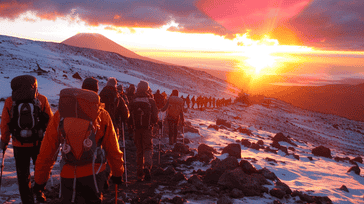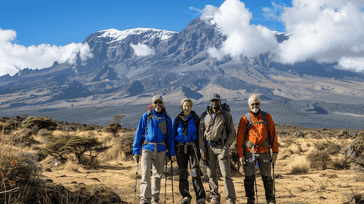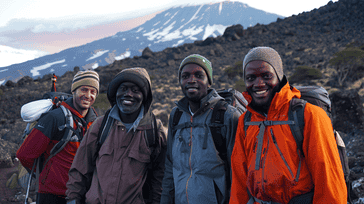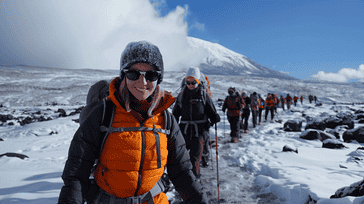Kilimanjaro Quest: Trekking Africa's Highest Peak

Embarking on a journey to the summit of Mount Kilimanjaro is an epic adventure that has captivated the hearts of travelers from around the globe. As the pinnacle of African destinations, Kilimanjaro offers more than just a trek; it's a traverse across diverse ecosystems, a test of human endurance, and a story that you'll recount for a lifetime. In this travel blog, we aim to equip the intrepid adventurer with essential travel tips, echoing the pulse of adventure travel, and the allure of unadulterated exploration.
Whether you're a seasoned hiker or a curious novice, climbing to Africa's rooftop is an accessible dream with the right preparation. We'll guide you through the trials, triumphs, and transformative moments that define the Kilimanjaro experience. Get ready to embark on a trek where every step brings you closer to the clouds, and every breath is a testament to the majesty of Africa's natural wonders.
Key Takeaways
- Tackle the heights of adventure travel by summiting Africa's highest peak.
- Discover practical travel tips for your expedition within these travel blog insights.
- Understand why Mount Kilimanjaro stands out among African destinations.
- Prepare to be inspired and challenged in equal measure by the Kilimanjaro trek.
- Learn how to make the most of your journey with essential advice for climbers.
- Gain an appreciation for the rich tapestry of landscapes and culture that Kilimanjaro embodies.
- Embark on a quest that transcends mere travel, offering a path to personal triumph.
Embarking on the Adventure: Preparing for Your Kilimanjaro Trek
Trip planning is crucial when embarking on travel to Africa, especially for those aiming to conquer Mount Kilimanjaro. Whether it’s the allure of the climb or the anticipation of awe-inspiring safari tours that beckons, a journey to Africa's highest peak requires thorough preparation. In the ensuing paragraphs, we'll explore the physical training, essential gear, and ideal times that make for a successful Kilimanjaro adventure.
Training and Fitness Tips for the Climb
Venturing into the realms of high-altitude trekking demands a level of fitness that can withstand rigorous activity. When planning your trip, incorporate cardiovascular exercises, strength training, and altitude acclimation into your regimen. Activities such as hiking on inclines, stair climbing, and long-distance running can mimic the demanding conditions you’ll face on the mountain. Additionally, practicing yoga and meditation can improve your breathing efficiency — vital for those lofty altitudes.
- Cardiovascular training: Essential for building stamina.
- Strength training: Focus on legs, core, and back to support the climb.
- Altitude preparation: If possible, train on hills or high elevations.
- Breathing techniques: To assist with oxygen intake at higher altitudes.
Gathering Your Gear: The Essentials for Mountain Trekking
Your gear is your lifeline while on the mountain. As such, it’s important to curate a list of essentials well before your departure. From weather-appropriate clothing to navigation tools, packing the right items can make all the difference in your Kilimanjaro experience.
| Category | Essentials |
|---|---|
| Clothing | Insulated jacket, moisture-wicking base layers, trekking pants |
| Footwear | Sturdy hiking boots, thermal socks, gaiters |
| Sleeping | Four-season sleeping bag, insulated sleeping pad |
| Accessories | Headlamp, trekking poles, sun protection |
| Nutrition and Hydration | Water bottles or hydration system, high-energy snacks |
Understanding the Best Time to Visit
Choosing the best time to visit is a pivotal part of your trip planning. Kilimanjaro’s fluctuating weather patterns influence both the difficulty of your trek and opportunities for wildlife sightings on subsequent safari tours. For optimal conditions, most adventurers aim for the drier months between June to October and January to March. These periods typically offer clear skies, less precipitation, and more stable temperatures, enhancing your chances for a successful summit and an enjoyable safari experience.
Climbing Kilimanjaro is not just about the summit; it's about embracing the spirit of Africa and its boundless sky. Choosing the right season lets the mountain reveal its true magnificence.
Exploring the Routes: Choosing Your Path to the Summit

For those seeking an adventure travel experience infused with African culture, climbing Mount Kilimanjaro offers a panorama of routes, each teeming with diversity and challenge. Your choice of path can significantly impact your journey, intertwining travel tips with cultural insights, which is why we're offering a dynamic travel blog-style breakdown to assist in making an informed decision.
The route you select not only dictates the scenery you will absorb but also the pace at which you will travel and your overall summit success rate. Below, find an in-depth comparison of the most famous trails leading to the rooftop of Africa. Consider how each aligns with your expectations for an adventure travel excursion:
| Route Name | Distance | Difficulty Level | Scenery Quality | Cultural Significance | Recommended for |
|---|---|---|---|---|---|
| Marangu | 72km | Moderate | Standard | Historical: First established route | Beginners, historical enthusiasts |
| Machame | 62km | High | Exceptional | Whiskey Route: Challenging yet scenic | Seasoned hikers, photo aficionados |
| Lemosho | 70km | High | Exceptional | Remote & pristine: Rich wildlife | Adventure purists, nature lovers |
| Rongai | 65km | Moderate | Standard | Northern approach: Less frequented | Those seeking solitude, dry season climbing |
| Shira | 56km | Variable | High | Plateau Start: Immediate high altitude | Experienced altitudinists |
| Umbwe | 53km | Very High | Good | Steep & Rapid Ascent: Least frequented | Thrill-seekers, time-pressed climbers |
| Northern Circuit | 90km | Moderate | Exceptional | Longest route: Circumnavigation of the peak | Those desiring a full Kili experience |
Trekking Kilimanjaro is a testament to personal endurance and cultural respect. Whether you're drawn to the historic Marangu route or seeking the extreme challenges of the Umbwe trail, understanding the terrain and traditions of each path ensures a richer, more memorable ascent. Bear in mind that each route—etched into the heart of Tanzania—offers not just a path, but a story woven deeply into the fabric of African culture.
Acclimatization Strategies: Tips for Beating Altitude Sickness
For many travelers planning a journey to the high peaks of Africa, understanding how to adjust to the altitude is as vital as packing the right gear. Altitude sickness can mar an otherwise incredible adventure, but with the right travel tips, you can prevent it and enjoy every step of your climb. Let's explore how to prepare your body for the higher elevations.
Gradual Ascent: Planning Your Climb to Cope with Altitude
Implementing a gradual ascent is key to allowing your body to acclimate properly. It's recommended that trekkers ascend no more than 1,000 feet per day once above 10,000 feet, with a rest day every 3,000 feet to help the body adjust. This method of trip planning reduces the likelihood of developing acute mountain sickness (AMS). Consider building extra days into your itinerary for acclimatization to ensure a smoother, safer ascent.
Hydration and Nutrition: Keeping Your Body Acclimated
Staying hydrated is crucial when traveling to high altitudes in Africa. Dehydration can exacerbate symptoms of altitude sickness, so increasing your water intake is essential. Aim for around 4-6 liters of water per day, adjusting as needed for your exertion levels and the climate. Additionally, your diet should be rich in carbohydrates, providing energy and helping maintain blood sugar levels. By focusing on your body's hydration and nutrition needs, you can significantly improve your acclimatization process.
- Drink clean, purified water to avoid illness and stay hydrated.
- Snack on a mix of complex carbohydrates and proteins for sustained energy levels.
- Avoid alcohol and tobacco, which can hinder the acclimatization process.
By following these travel tips, incorporating a thorough trip planning process, and being mindful of your body's responses to altitude, you will set yourself up for a more enjoyable and health-conscious exploration of Africa's stunning high-altitude destinations.
Travle, Africa: A Closer Look at Kilimanjaro's Cultural and Natural Diversity

Mount Kilimanjaro is not only a towering beacon for adventure travel but also a substantial repository of African culture and natural wonders. This legendary African destination offers more than a climb—it presents an opportunity to explore the vibrant tapestry of life that thrives on its slopes and in the surrounding lands.
Flora and Fauna Unique to Kilimanjaro
The ascent up Kilimanjaro is a fleeting journey through distinct ecological zones, each with its flora and fauna that inspire awe and respect for nature's diversity. Safari tours are enriched by sightings of exotic species ranging from the towering trees of the montane forest to the hardy plants of the alpine desert. Here's a glimpse of the natural treasures that await:
- Colobus monkeys swinging through the lush rainforest canopy.
- Impressive lobelias and giant groundsel, which flourish in the moorland zone.
- Chameleons, honeycreepers, and sunbirds adding bursts of color and life amidst the green.
- The stoic silhouette of the elephant and cape buffaloes on the Shira plateau, a reminder of the area's raw beauty and untamed spirit.
The Local Chagga People and Their Traditions
The Chagga, the indigenous dwellers at the base of Kilimanjaro, are integral to the cultural landscape. Their rich heritage, agricultural expertise, and spiritual connection to the mountain paint a vivid picture of endurance and tradition.
| Chagga Cultural Element | Description |
|---|---|
| Banana Beer | Homebrewed traditional beer made from ripe bananas and sprouted millet, encapsulating the communal spirit of local gatherings. |
| Chagga Huts | Conical structures with thatched roofs, traditionally used as homes, exuding the practicality and resourcefulness of the tribe. |
| Uru Waterfalls | A sacred site for the Chagga, often associated with legends and cultural ceremonies, showcasing the tribe's reverence for nature. |
| Kihamba | Intensive agroforestry systems that highlight the Chagga's advanced farming methods and their symbiotic relationship with the land. |
| Kilimanjaro Coffee | World-renowned for its flavor, cultivated on the fertile volcanic soils of Kilimanjaro's slopes, reflecting the Chagga's agricultural legacy. |
Embarking on safari tours to witness Kilimanjaro's stunning biodiversity and engaging with the Chagga's enduring customs are unique experiences that deepen travelers' appreciation for African destinations. This is where the heart of adventure travel beats, at the crossroads of untamed wilderness and living culture.
Kilimanjaro's Conservation Efforts and Ecotourism Impact
The majestic Mount Kilimanjaro is not only a symbol of adventure travel but a testament to the efforts made in preserving one of Africa's most precious ecosystems. With its snow-capped peak and rich biodiversity, Kilimanjaro has become the epitome of ecotourism in Africa, where each step a traveler takes is made with the intention of leaving a light footprint on the environment.
Maintaining the Mountain: The Role of Responsible Trekking
Responsible trekking practices play an essential part in the conservation strategies set to ensure the sustainability of this African icon. Travel tips for visitors to Kilimanjaro include adhering to established trails, minimizing waste, and respecting local wildlife habitats. By engaging in these mindful practices, trekkers contribute to the mountain's longevity and help maintain its natural state for future adventurers to cherish.
Ecotourism: Supporting Sustainable Travel in Africa
Ecotourism is not simply a buzzword; it is a commitment to travel that emphasizes conservation, community, and educational aspects of visiting natural areas. In Africa, where ecotourism efforts aid in both environmental protection and economic development, travelers are encouraged to support local initiatives that foster sustainable tourism. This means choosing eco-friendly lodges, purchasing local crafts, and engaging with guides who are knowledgeable about environmental conservation.
| Principle of Ecotourism | Benefit to Kilimanjaro | Tip for Travelers |
|---|---|---|
| Minimize Impact | Reduces trail erosion and habitat disturbance | Stick to the trails and pack out all waste |
| Support Local Economy | Boosts employment and resources for conservation projects | Buy local products and services |
| Education | Increases awareness and promotes ongoing conservation efforts | Take part in guided tours and attend conservation talks |
| Respect for Local Culture | Ensures the Chagga people's culture is celebrated and preserved | Learn about local customs and traditions |
| Contribute to Conservation Efforts | Aids in funding Kilimanjaro National Park's preservation projects | Consider donations to reputable conservation organizations |
As Kilimanjaro continues to attract those who seek adventure travel, fostering a deeper understanding of ecotourism becomes vital to its preservation. Travelers equipped with knowledge and a desire to support sustainable practices ensure that this African jewel retains its allure for generations to come.
Conclusion

Throughout this travel blog, we've traversed the vast landscape of practical travel tips and invigorating tales that knit together the grand tapestry of Kilimanjaro. The mountain's allure calls to the intrepid explorer within each of us, promising a symphony of culture, nature, and personal accomplishment. We've armed you with the requisite knowledge to plan this monumental journey, from understanding the nuances of trip planning to embracing the steps toward sustainable tourism in one of the most coveted African destinations.
Partaking in safari tours at the foot of Kilimanjaro offers not just a walk among wildlife and stargazing beneath clear African skies, but also a richer connection to the Earth and its inhabitants. By choosing to immerse yourself in the authentic experiences Kilimanjaro and its surrounding communities offer, you become part of a story much larger than any single adventure. It's a narrative woven with the dedication of local culture, the majesty of untamed landscapes, and the collective efforts of conservationists preserving this wonder for future generations.
As we bring our journey to a close, we envision this guide to be a lantern in the wilderness, illuminating your way as you embark on your own Kilimanjaro quest. Whether you're seeking rejuvenation from the monotony of everyday life or aiming to quench an undying thirst for adventure travel, Kilimanjaro beckons with its timeless challenge. We encourage you to rise to the occasion, equipped with the insights shared here, as you pursue the peak of personal triumph and the joy of discovery in the heart of Africa.
FAQ
What makes trekking up Mount Kilimanjaro a must-do adventure travel experience?
Mount Kilimanjaro offers a unique adventure travel experience as Africa's highest peak, drawing trekkers from around the world. The climb challenges and rewards with stunning views, diverse ecosystems, and the opportunity to stand on the roof of Africa. It's a chance to test your limits and immerse yourself in the natural beauty and the surrounding African culture.
How should I prepare physically for a Kilimanjaro trek?
Preparing for a Kilimanjaro trek involves a combination of cardiovascular exercises, strength training, and hiking. Gradually increasing your fitness levels to cope with the demands of altitude and terrain is essential. Also, consider practicing on hills or staircases as it helps to mimic the climbing experience.
What gear do I need for a successful climb up Kilimanjaro?
Essential gear for trekking Kilimanjaro includes thermally efficient clothing, waterproof and windproof layers, good quality hiking boots, a sleeping bag suitable for sub-zero temperatures, a day pack, headlamp, trekking poles, and proper hydration equipment. It's advisable to check with your tour operator for a comprehensive list.
When is the best time to plan a trek to Kilimanjaro?
The best times to trek Kilimanjaro are during the dry seasons, which are from late June to October and from late December to March. These periods typically offer clearer skies and less precipitation, making for safer and more enjoyable climbing conditions.
How do I choose the right route for my Kilimanjaro trek?
Choosing the right route depends on your experience level, fitness, and preferences for scenery and crowd. Some routes like the Marangu and Machame are more popular and offer communal experiences, while others like Lemosho and the Northern Circuit are longer, providing more acclimatization time and a chance to enjoy quieter trails.
What strategies can I use to prevent altitude sickness on Kilimanjaro?
Preventing altitude sickness involves a gradual ascent, proper acclimatization, staying hydrated, and eating a balanced diet. Listening to your body and communicating with your guide are vital. It's also helpful to consider taking altitude sickness medication after consulting with a healthcare provider.
What unique wildlife might I see during my Kilimanjaro trek?
Kilimanjaro is home to a variety of wildlife, especially at the lower levels. Trekkers might spot blue monkeys, colobus monkeys, bush babies, and diverse bird species. As you ascend, wildlife becomes sparse, but the changing vegetation zones offer their own unique flora.
Can you tell me more about the local Chagga people and Kilimanjaro?
The Chagga people are indigenous to the Kilimanjaro region, known for their rich traditions and successful agricultural practices. Visitors can learn about their cultural heritage, which includes intricate irrigation systems, traditional houses, and the historical significance of coffee and banana cultivation in their society.
How does responsible trekking contribute to Kilimanjaro's conservation?
Responsible trekking helps conserve Kilimanjaro's delicate ecosystems by minimizing environmental impact. Trekkers can contribute by following the Leave No Trace principles, staying on marked trails, disposing of waste properly, and respecting wildlife and natural resources.
What is ecotourism and how does it impact travel in Africa?
Ecotourism is responsible travel to natural areas that conserves the environment, sustains the well-being of local people, and involves interpretation and education. In Africa, it supports conservation efforts and promotes sustainable community development by involving locals in tourism activities and ensuring a portion of tourism revenue goes back into protecting the destinations travelers love.
